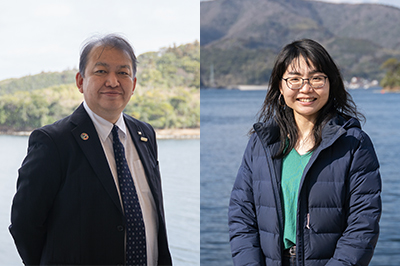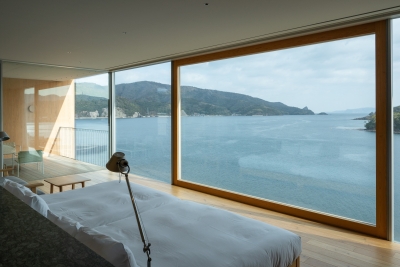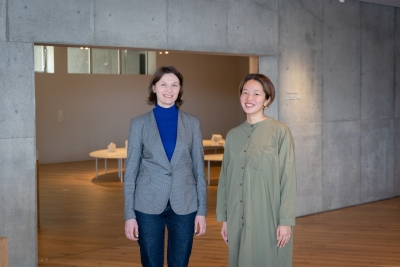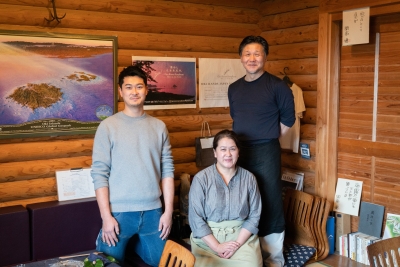Finding Value in What Is Available The Fascinating Nature, People, History, and Food Culture of the Oki Islands

The Oki Islands are located 40–80 km north of the Shimane Peninsula. The Oki Islands consists of 180 islands of various sizes, four of which are inhabited, and blessed with abundant nature. These nature-rich remote islands have long been a place for interaction between people and culture. Historically, there were well-known as the place where Retired Emperor Go-Toba and Emperor Go-Daigo were banished, while the islands also flourished as a stopover for ships sailing the Sea of Japan during the Edo period. The rich and diverse cultures that have developed throughout this long history has been carried on to the present day. Fascinated by the charming way of life, many people have also moved to the Oki Islands. Records of the Oki Islands appear as far back as in the Kojiki, or Chronicles of Japan. Looking back on this history, today these migrants are working to create a new future for the islands. As remote islands, there are some things that are “missing” from the islands. However, people here have realized what “exists” only on these remote islands.
Unique Regional Characteristics
The Oki Islands are home to numerous scenic spots and many areas are associated with Shinto rituals. The structure of the land, its history and culture, and unique ecosystems have led to the UNESCO Global Geopark designation. UNESCO Global Geoparks are defined as “single, unified geographical areas where sites and landscapes of international geological significance are managed with a holistic concept of protection, education and sustainable development.”
“I want children to be proud of being from the Oki Islands. That’s why I want to make there where they can be proud of,” says Kazuhiro Nobe, chairman of Oki Islands Geopark Management Bureau and one of the instigators of the Oki Geopark. Aiming to revitalize the area through Geopark designation, in 2009 Nobe began persuading the governments and relevant tourist organizations of the four inhabited islands. The islands were designated a Global Geopark in 2013, and with Global Geoparks becoming a UNESCO program in 2015, the Oki Islands were subsequently recognized as a UNESCO Global Geopark. The attractions of this majestic Geopark are widely communicated through three themes unique to the islands: the origins of the land, the unique ecosystem, and the lifestyles of locals. The Geopark designation has fostered a sense of confidence and civic pride among the local people, inspiring them to think about new forms of tourism for the islands.
“We are currently making every effort to build a sustainable tourism model that brings together education, environmental protection, and tourism,” says Nobe, who is constantly striving to revitalize and promote the islands. In 2022, Nobe concluded a cooperative partnership agreement with JTB Corporation, and since then the public and private partners have been working on branding, regional revitalization, and content creation.
Today, five employees from JTB Corporation are working on the four inhabited Oki Islands. Mr. Mouri , initiator of the project and general manager of regional interaction, says “Although the islands boast an array of world-class tourism resources, their awareness is still low. By further enhancing the appeals of the area, I hope to use tourism to boost the islands’ economy.”
Meanwhile, Ms. Takehara, who works in Ama Town, says “My aim is to look for regional attractions by ourselves, think about how to promote and communicate them, and ultimately provide new tourism products.” The JTB employees on each inhabited island work together, and on occasion compete with each other, while uncovering local appeals and developing new tourism products. This partnership agreement will no doubt enhance the appeals of the Oki Islands even further.
A Hotel as a Hub for the Geopark 【Entô】
With distinctive glass windows, Entô is the first facility in Japan that is both a hotel and a central hub for a UNESCO Global Geopark . The facility also houses Discover, an exhibition room where visitors can learn about the origins of the earth and the Oki Islands, as well as about the area’s various charms. The aim is to let visitors fully experience the splendor and fun of the Geopark. Atsushi Aoyama is the representative director of Ama Holdings , the organization behind Entô.
“The concept was “a hotel that looked as though it had been dropped onto the earth”. In front of the impressive natural scenery, there was created to be a place where visitors can feel at one with nature and experience the Geopark first-hand,” says Aoyama.
After the islands were designated as a UNESCO Global Geopark, Aoyama realized that the area was not effectively utilizing the value as a Geopark. He therefore explored a new definition of luxury thatwas entirely different from urban luxury. He thus conceptualized a hotel where guests could experience the surrounding nature and island life, interact with island locals, and spend some relaxing time in a luxurious space.
This concept led to the creation of Entô, an environmentally friendly facility constructed with simplistic design and colors that do not disturb the landscape. Entô will continue to play a role in sustainable tourism as the entrance to the Oki Islands UNESCO Global Geopark.
[Entô website: https://ento-oki.jp/en/ ]
Island Life 【Nakagami Oyster Farm】【Takuhi Shrine】
Hikari Nakagami of the Nakagami Oyster Farm—the first organization to successfully cultivate rock oysters in Japan—returned to the islands from Osaka to succeed his father’s seaweed and scallop farm. To develop the fishing industry on Nishinoshima Island and promote the employment for local youth, Nakagami later began cultivating rock oysters. At the time, natural rock oysters were sold at a high price.
Of his thoughts at the time, Nakagami says, “Unless I created something that didn’t exist, I knew I wouldn’t be able to move forward. Rather than catching up with something that already existed, I thought it was important to do something that hadn’t been done in Japan before.”
Today, rock oysters are cultivated on all four inhabited islands, and have developed into an Oki Islands delicacy. The mountains and the sea are close—as such, there are many inlets that are said to be ideal for oyster cultivation, while nutrients from the mountains help to enrich the nearby waters. Further, the small population means the water is not polluted, forming a set of optimal conditions for oyster cultivation. Rock oysters of the islands are carefully cultivated for three to six years.
Michihito Matsuura is the 21st-generation chief priest of Takuhi Shrine, an Important Cultural Property of Japan. “Takuhi Shrine is a place of worship for people who believe in the mysterious power of nature, and where we can catch a glimpse of the lives of people who have coexisted with nature.”
Takuhi Shrine is positioned on the slope of tall Mt. Takuhi, and as such has long been revered by sailors as a landmark for navigation. The shrine is also depicted as a famous spot in the Oki Islands in the Famous Views of the Sixty-odd Provinces, a series of woodblock prints by Utagawa Hiroshige.
“There are 16 shrines on the Oki Islands with 1,000-year histories,” says Matsuura. With more than 150 shrines of different sizes, and supposedly more than 300 during the Edo period, the Oki Islands are a place of the gods.
Interacting with the shrines and beliefs of the Oki Islands is the ideal way to learn what people in the past felt about nature and what they valued in their daily lives.
[Nakagami Oyster Farm website: https://www.okihikari.com/ ]
[Takuhi Shrine website: http://takuhi-shrine.com/index-en.html ]
The Entrance to Tourism 【Oki Islands Geopark Management Bureau】
Sawako Ishihara from Kanagawa Prefecture and Jagoda Woloszyn from Poland are two key members of the marketing team of the Oki Islands Geopark Management Bureau.
Ishihara, who previously worked in tourism marketing in Singapore, says she decided to move to the Oki Islands because she felt it was a place where she could both live and take on new challenges. The travel industry is currently undergoing a paradigm shift from group holidays to individual holidays that are tailored to personal tastes and preferences. With her skills in marketing, Ishihara will be a key part of Oki Island tourism in the future.
Woloszyn is in charge of personnel development and marketing. She works to promote interaction between children from the Oki Islands and children from Geoparks around the world, as well as supporting the development of civic pride. Despite working on a remote island in Japan, interacting and working with people from around the world is one of the attractions of the UNESCO Global Geopark.
She says, “The Oki Islands are home to many treasures. I hope to communicate these treasures more widely and let people in Japan and around the world learn about the real Oki Islands.”
The role of the Oki Islands Geopark Management Bureau is to examine how to protect the environment while using the Geopark designation for education and tourism. To shift from consumption-based tourism to sustainable tourism, it will be important for locals and many others to work together to widely communicate the appeals of the area. Although it is not easy for all those involved to work in step, both Ishihara and Woloszyn say that they are only at the starting point and there are still many things they want to achieve. Their endeavors are set to continue.
Island Expressions through Cuisine 【Chez SAWA】【Geo Resort Symphony/Cafe la Mer】
Chez Sawa is a French restaurant that uses local produce from the islands for local consumption. In a modernized old Japanese house, diners are treated to stunning dishes that appear too good to eat.
Nagano-born Momiichi Satono is the head chef at Chez Sawa. “To avoid getting overly creative, I make sure to stick to the French foundation while expressing island-inspired flavors.” Running the restaurant alongside Satono is Sawa Okada, who herself comes from Hyogo Prefecture.
“After training in France and Germany, I started working at a major resort hotel, but I wasn’t satisfied with simply making efficient, fixed menus. I wanted to set up my own small restaurant with just one group, for example,” says Satono, who moved to the islands after visiting there on a trip. He continues, “It’s actually quite enjoyable making dishes with ingredients only from the island.”
Okada, meanwhile, moved to the island a year late, hoping to develop a form of agriculture that would link the production of ingredients to their consumption in restaurants. She launched her own farm, Itadaki Farm, carefully growing ingredients to use in the restaurant.
In addition to growing vegetables, Okada also raises local breed of gamecock. These chickens are raised stress-free in the natural environment of the remote islands and served at the restaurant. The gamecock are bred from a well-known premium variety from Nagano region, and are distinctive for their strong umami and firm texture. In a remote island where is supposed to boast seafood, these gamecocks, with a presence that is as strong as that of the seafood, further enhance the dishes on offer.
Itadaki Farm is also aiming to achieve circular agriculture, using manure from the gamecocks and cooking scraps as fertilizer. On this small remote island, Okada is regularly exploring environmentally friendly methods.
Enjoying lives on the island and firmly rooting themselves in the area, the duo are constantly looking for delicious ingredients available on the island, and producing what they cannot find themselves. They say that in the future, their dream is to set up an adjoining lodging.
“For people who have chosen to visit Oki Island, our aim is to provide entirely unique time and dishes that will become a mental picture of their trip and of their life,” says Mr. and Mrs. Matsuyama, owner of Geo Resort Symphony and Cafe la Mer.
As if in another world, these establishments are located in a hidden village, off the beaten track. The concept for the lodging and cafe is “Resonance of the sky, sea, forest, wind, and time.”
The creative cuisine conjured up by Mr. and Mrs. Matsuyama is one-of-a-kind and beyond French, Italian, or any other category. With a comfortable cottage and exciting experiences and outdoor activities, guests can devote themselves to the abundant natural surroundings and spend some time in luxury.
Including the cuisine, a recurring overall theme is a constant awareness of the local terroir, a term frequently used in the wine industry.
“I don’t think there is a word in Japanese that can accurately describe ‘terroir.’ Therefore, I have coined the term “fudomi” to describe it. Feeing the “fudomi” of the island, I strive to create dishes that are more in tune with the individuality of living things with minimal complex. Being satisfied with what we have and using it effectively is the purest and most natural approach,” says Matsuyama.
In pursuit of the terroir developed by the natural environment of Oki Island, including climate, topography, geology, and water quality, Matsuyama collects and catches seasonal ingredients from the mountains and sea himself. Working with fishermen, hunters, and others who offer their support, he is creating an excitement that cannot be found in other regions.
Explanation of Matsuyama’s cuisine is also a major factor. His thorough understanding of the ingredients and the cuisine as a whole enables him to create stories that fascinate all who hear his culinary vision. His refined sensitivity and sensibility, as well as the deliciousness using everything he can, attracts gourmets from around the world to this far away remote island.
[Chez SAWA website: https://ya5p400.gorp.jp/ ]
[Geo Resort Symphony Instagram: https://instagram.com/georesortsymphony?igshid=NTc4MTIwNjQ2YQ== ]
Creating New Industries 【Saki-mikan】【Shimashoku no Terakoya】
Takashi Tango joined the Ama Saki-mikan Regeneration Project in 2013 and since then has been working to cultivate the northernmost mandarin oranges in Japan.
“At first, I made a lot of mistakes. We began by cutting down thickets and securing farmland, but trying to grow mandarin oranges on a remote island in the Sea of Japan, with heavy snowfall and strong sea breezes, is a constant process of trial and error,” says Tango.
Production of Saki-mikan mandarins began around 1955, and at the peak of production more than 10 hectares of mandarins were cultivated. However, due to the aging farming population and lack of successors, the industry was in decline. Local governments and the Japan Agricultural Cooperative thus stepped in and led efforts to regenerate the industry. It was at this time that Tango put himself forward and moved to the island.
Saki-mikan mandarins have been described as “nostalgic mandarins with a perfect blend of acidity and sweetness.” Today, the production of these mandarins is continuing to increase. When it is time to harvest, many locals and high school students offer their help, making it a winter tradition in the area. While enjoying the benefits of nature, people here work together to overcome the harshness of it. It is a lifestyle unique to remote islands.
Shimashoku no Terakoya is a program that participants who live on the island learn the fundamentals of washoku from a professional chef. The program’s theme is “bringing shape to the day,” and uses only ingredients from the islands to create dishes with menus decided on a case-by-case basis.
Program coordinator Kazumasa Tsunemitsu , who came to the island from Osaka, says, “We can’t use what we don’t have. Instead of procuring ingredients from all over Japan, we are grateful for what we have and cook with what we have. We want participants the technique of cooking with limited ingredients and adopt this attitude.”
As the types and volume of ingredients differs by day, things do not always go according to plan, and participants have to be creative. Participants also learn about ingredients from the sea, mountains, and local villages, and so have the opportunity to interact with local producers and experience harvesting and fishing for themselves. In addition to mastering knife skills and broth-making techniques, participants will deepen their understanding of ingredients through stories unique to the area.
“For example, on a day when soybeans could be harvested in a nearby village, we then go to the sea to collect bittern so we can make tofu. Because it is a small island, the ingredients for cooking are simple to combine. It is this simplicity that we are able to teach cooking with ingredients from the whole island,” says Tsunemitsu.
Focusing on things unique to a small remote island, Tsunemitsu is constantly striving to make full use of what is available.
[Ama Saki-mikan Regeneration Project Facebook: https://www.facebook.com/SakimikanPJT/ ]
[Shimashoku no Terakoya website: https://washoku-terakoya.com/ ]













